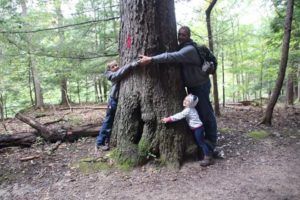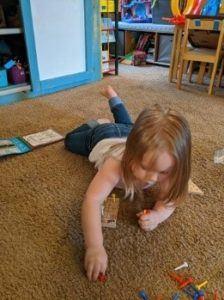Uncategorized
Hiking with the family is a great way to relax, exercise, play, learn, and explore new things. From a therapist perspective, this is also a low-stress and fun way to work on your child’s goals, no matter what the discipline. See below for ideas to enhance your hiking experience!
Physical Therapy
Climb, throw, and jump!
- Balance-Find trails that are uneven or not paved—a perfect opportunity to strengthen ankles, feet, toes and balance reactions!
- Strength- To get up and down those big hills we get use many different muscles. This challenges strength in our legs and our core.
- Natural Obstacle Course- Do you see that big log in the way or next to the path? Use it to balance, climb over, crawl under, or jump off!
- Body Awareness-Walking across the river on slippery rocks is a great way to address balance, body awareness, and motor planning. As always be very cautious around water.
- Throwing-Throwing rocks into the creek is a fun way to work on coordination for throwing. Make it a challenge to add in distance or aiming for an object.
- Jumping- Try jumping over or splashing in some puddles to build up that leg strength!
- There are so many ways to strengthen our bodies when playing outside!

Occupational Therapy
A multi-sensory experience!
- Sounds- Birds singing, trees creaking, or crickets chirping. The various frequencies that children hear allows for improved body orientation and spatial awareness!
- Sight and Smell- Search for flowers, rocks, animal tracks, and pine cones! These can also be great for crafting after the hike to target fine motor skills!
- Touch- Encourage kids to take their shoes off and feel the various textures on their feet—rocks, sand, water, mud or grass!
- Executive Functioning- Following a trail map targets directional skills for older kids.
- For the little explorers– Staying on the trail while scanning the woods is great for visual perceptual skills!
- Nature can be a great way for children to foster imagination and creativity!

Speech Therapy
Oh, the Things You Can Say!
Early Language/First Words: Keep words simple, “go,” “wet,” “up,” “in,” “splash,”
- Language Comprehension: Follow directions and teach spatial concepts such as “Walk through the tunnel,” “Go up the hill,” “Walk around the tree”
- Vocabulary and Describing: Work on new words and describing what you see, feel or hear. “The mud is sticky and slimy!”, “Can you find a bumpy rock? What else is bumpy?” “The water is cold,” “Do you see the bird way up high in the tree?” “The bridge is wiggling!!
- There is so much to talk about, learn and explore in nature!
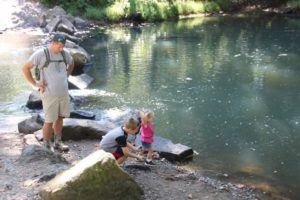
Always remember general safety when going on a hike and ask your healthcare provider if you have any concerns. For more generalized tips and tricks for hiking with kids, check out the following resources. Happy hiking!
American Hiking Society https://americanhiking.org/resources/hiking-with-kids/
National Park Service https://www.nps.gov/subjects/trails/hiking-with-kids.htm
Hike it Baby https://hikeitbaby.com/blog/get-family-on-trail-with-proven-helpful-
For more information, visit https://www.abcpediatrictherapy.com/
Blog and pictures provided by: B. Kerbe Shephard, OTR/L, Michelle L. Huss, M.A. CCC-SLP, Rachel Menkedick, PT, DPT
Read MoreLife Skills to Teach your Child during Quarantine
As parents, we have a unique situation which allows us to spend a lot of time with our children at home. As an OT, I can’t help but think of it as a great opportunity to teach your kids some basic life skills, that will stay with them long past quarantine life!
- Cooking and baking. Kids learn best when they can use their sensory systems (hear, smell, taste, touch, sight) and baking and cooking entail all of them! It is a phenomenal sensory opportunity, from dealing with new textures on their hands or face, new smells and tastes, tolerating loud noises…it covers lots of areas that could be hard for your child. Other skills that are targeted with baking and cooking are: using measuring cups (bilateral skills, math), stirring with spoon (bilateral and fine motor skills), following a recipe (time management, sequencing steps, reading), kitchen safety (safe vs. unsafe situations, being aware of potential hazards, how to use fire extinguisher, when to call 9-1-1), and cleaning up (how to hand wash and dry dishes, load dishwasher, etc.). Not to mention it is a great way to pass time with a reward of food at the end!
- Carry on a conversation. As I child, I was horribly shy and would have benefited from some coaching. Practice people within your family or maybe even over FaceTime. Work on how to introduce themself, ask questions and wait for a response, eye contact, active listening, and how to politely exit a conversation. You might be surprised how much a little bit of practice can make a huge difference in your child’s confidence in social situations.
- I am by no means a seamstress, but I can definitely sew a button. Even if it is something basic, you may tap into an interest they previously would not have experienced. Start small with tasks like, sewing a button, threading a needle and hand stitching two pieces of fabric together. If you are more sewing savvy, trying making a pillow or maybe even making face masks for your family! Sewing targets fine motor and bilateral skills, executive functioning (sequencing steps, following a pattern, etc.).
- Not a glamorous task in the eyes of child, but great life skills! Obviously, not every child can complete every chore due to safety issues and age restrictions, but again start simply for your younger children (put clothes in hamper, put dishes in sink, rinse dishes, put away toys, etc.) and more complex for your older ones (scrubbing shower, loading and unloading dishwasher, dusting, running the vacuum, washing windows, sweeping floors, etc.) . Chore charts can be a big motivator for kids of all ages and help you get the chores done.
- Doing Laundry. This can entail a LOT of steps that target different skills. For example, sorting clothes by colors (executive functioning), carrying laundry basket and loading/unloading washer or dryer (heavy work, sensory input), when to start and stop loads of wash (time management), folding clothes (bilateral skills and motor planning), and putting clothes away (organizational skills). Either have your child do a portion or complete all the steps, it’s never too early to foster independence and lend you some help on laundry day.
- Use tools (with supervision of course!). Using tools can be incredibly motivating for kids and help them feel great satisfaction by building and creating. Again, using tools requires fine motor and bilateral coordination, eye hand coordination, safety awareness, and executive functioning. Again, keep things easy for younger kids (using a hammer/nail or screwdriver/screw) and maybe take on a full project for older kids (building a birdhouse, assisting in fixing the mailbox, etc.).
- Budgeting money. Help your child understand the value of a dollar and how to manage money. Try activities like using a weekly allowance to “buy” preferred toys or activities. Offer opportunities to make and spend money. This will give them insight and help them learn how to count change, prioritizing wants, and truly understand that things come with a cost!
I hope you can take this extra time with your children to teach them some lifelong skills. Check in with your OT for more suggestions on how to make your child more independent!
For more information, visit https://www.abcpediatrictherapy.com/
Source: https://www.businessinsider.com/11-life-skills-teach-your-kids-at-home-during-quarantine-2020-4
Read More
Model language for your child
-Read with the rhythm of the book
-Leave out words and have the children fill in words (after multiple repetitions) “Green frog, green frog. What do you ______? I see a blue _____. Looking at me.” Pause for a few seconds then fill in the words: “HORSE”
-Read and make statements to describe
“This is a duck, it is yellow, it says quack-quack”
Ask what questions – if they don’t know give a choice of 2, “duck or sheep”
-What color is this animal?
-What animal is this?
-What sound does it make?
-What does it eat?
Ask where questions -if they don’t know give choice of 2, “farm or house”
-Where does the animal live?
-Work on spatial concepts and vocabulary (in the water, up in the sky, in a nest, on top of a lily pad, in a barn)
Talk about animal characteristics (Expansion Expression Tool)
If they don’t know give a choice of 2, “fur or feathers”
-Group group: What group or category does it belong in? (farm animal or pet)
-Blue do: What does it do?
-What does it look like?: (describe size, shape of its body, color)
-What is it made of?: (fur, wool, feathers, hair, skin)
-Pink Parts: (legs, webbed feet, fins, eyes, beak, wool, ears etc)
-White where: where does it live?
-What else do I know? (fun facts/observations)

Expansion activities:
Color match sorting bears
Color match M&Ms, Fruit Loops etc
Counting and graphing
Print and copy letters
Starts with Letter
Brown bear snack – teddy grahams
Retell story
Make puppets with popsicle sticks or paper bags
Make your own brown bear book
http://aisforadventuresofhomeschool.blogspot.com/2018/09/brown-bear-brown-bear-activities.html
http://www.1plus1plus1equals1.com/BrowBearBrownBear.html
http://www.Teacherspayteachers.com
https://childhood101.com/brown-bear-brown-bear-book-themed-sensory-tub/
http://doodlebugsteaching.blogspot.com/2011/07/brown-bear-brown-bear.html
For more information, visit http://www.abcpediatrictherapy.com
Read More
Are you having trouble motivating your child to practice their speech and language skills at home? Your child’s speech therapist is likely assigning tasks to practice at home throughout the week to reinforce the skills they’re learning in therapy. Home practice can make a huge difference in their progress and usually means faster improvement. Speech therapy isn’t an easy fix and it requires a lot of hard work and consistent practice over many months or even years. Home practice does not have to be boring! Below is a list of applications, websites, and games that you can utilize to make home practice fun:
- Applications
- My PlayHome
- Compatibility: iPhone, iPad, and iPod touch
- Price: $3.99
- Description: My PlayHome is an interactive doll house game that contains a variety of male and female characters that can eat, drink, cook, shower, sleep, and so much more. Your child can explore every room in the house while enjoying the colorful and detailed illustrations.
- How to use it:
- Expressive language skills: Labeling actions and common objects, producing regular and irregular past tense verbs, answering wh- questions, describing picture scenes, telling how common objects are used, naming categories, producing he/she pronouns and regular plural -s.
- Receptive language skills: Identifying common items, understanding verbs in context, understanding use of common objects, following directions, and understanding pronouns.
- Why it works: My patients absolutely love this game. It is so fun and motivating- they don’t even realize they are working on a variety of language skills!
- My PlayHome
- Articulation Station
- Compatibility: iPhone, iPad, and iPod touch
- Price: Lite version is free, individual sounds range from $3.99 to $7.99, and full version is $59.99
- Description: The application includes 22 different sounds and 6 engaging articulation activities to help your child speak and pronounce their sounds more clearly.
- How to use it: Select the individual sound(s) your child is working on in speech therapy and practice at the word, phrase, sentence, or story level.
- Why it works: The application is fun, colorful, and engaging. You can practice your child’s sounds through flashcards, matching games, rotating sentences, unique sentences, and stories. The activities are so fun that my patients often forget they are “working” on their articulation skills.
- Websites
- Home Speech Home
- Link: https://www.home-speech-home.com/
- Description: Home Speech Home is a website created by two certified speech-language pathologists. This website offers a variety of activities and word lists to practice articulation, apraxia, language, and stuttering principles. In addition, speech and language developmental norms and an overview of various speech and language disorders are also included.
- How to use it: I frequently utilize the word lists feature with my older patients. I select the specific sound(s) that my patient is working on and incorporate the words while playing their favorite board game or within conversation. You can practice their articulation skills at home with premade words, phrases, sentences, and stories.
- Mommy Speech Therapy
- Link: http://mommyspeechtherapy.com/
- Description: Mommy Speech Therapy is a website created by a certified speech-language pathologist. This website offers a variety of free articulation worksheets that include colorful pictures of your child’s specific target words, as well as helpful tips and tricks on how to increase your child’s speech and language skills at home.
- How to use it: You can select your child’s specific sound(s) and print out the associated free articulation pictures, cut them into individual pictures, and play a variety of games at home. You can hide the pictures around the house and have a “scavenger hunt” and ask your child to name the pictures when they find them. You can print out an extra page and play Go Fish or a matching game with the pictures while reinforcing their articulation skills. The options are limitless!
- Games
- Guess Who
- How to play: You can target a variety of language and articulation skills with this classic board game. Guess Who is great for working on he/she pronouns, asking questions, answering yes/no questions, producing grammatical forms (e.g. do/does, has/have), and articulation skills at the conversational level.
- Hedbanz
- How to play: Hedbanz is a fun way to work on naming categories, answering yes/no questions, turn taking, and articulation skills while your child guesses the identity of the card they’ve been dealt.
- Simon Says
- How to play: Simon Says is a quick and easy game to work on identifying common objects (e.g. body parts), following one-step directions, as well as directions of increasing length and complexity.
For more information, visit https://www.abcpediatrictherapy.com/childrens-therapy-serving-dayton-and-cincinnati/pediatric-speech-therapy-in-dayton-cincinnati-oh/
Read More
A few facts with Treadmill Training at ABC Pediatric Therapy
-Appropriate in our ABC setting for Delayed Walkers with no neurological or medical diagnosis such as Cerebral Palsy or Down Syndrome
– Performed for 15 minutes total of a session with a rest break as needed
– Performed 1-2x/week for total of 6 weeks or more weeks
– Therapist provides cues to promote/facilitate appropriate form
– Therapist will increase speed and incline on the treadmill as patient tolerates it
– Research shows it can improve scores on GMFM and 10 meter walk test compared to delayed walkers not performing the treadmill training = faster progression towards walking independently!
Would your child benefit from treadmill training? Ask to speak with an ABC Physical Therapist today! ?
Visit our website for more information: http://www.abcpediatrictherapy.com
Read MoreStarting at the age of 2, children begin to learn how to draw basic lines and shapes. It is developmentally appropriate for your child to draw a vertical line by 2 years old, horizontal line by 2.5 years old, a circle by 3 years, a cross by 3.5 years old, and a square at 4 years old. By the age of 5, children should be coloring inside of lines independently without any deviations. Children in kindergarten will be introduced to forming letters in the alphabet, if not beforehand in pre-school. Children should have emerging hand preference by the age of 18 months, increasing preference by age 2, with hand dominance firmly established by the age of 3.5 years. These are important fine motor skills to develop as functional handwriting progresses in first and second grade. Incorporating sensory techniques and repetition help increase the motor learning. Children also enjoy the response of sensory feedback during activities. Movement and sensory feedback help increase a child’s focus, learning ability, body awareness, and memory.

Various sensory motor activities can be used to facilitate fun with handwriting!
• Using popsicle sticks to form uppercase letters with straight lines
o one popsicle stick being 1 single side
o use a finger tip, then also crayon or marker to trace over top each popsicle stick to re-enforce that motor learning for each letter multiple trials
• Using Wiki-Sticks to form any shapes or letters, then trace over shape or letter formed with finger
o Including verbal prompts when tracing over top can facilitate speech and language, and also give auditory feedback for better learning
• Use a mini chalkboard to form shape or letter with chalk, then go over it with a wet sponge, and finally trace over with a paper towel to dry
• Use shaving cream or sensory medium for messy play (pudding, whip cream, yogurt, finger paint) to draw shapes and letters in with finger tip
• Manipulate play-doh by using hands to roll play doh into short or medium sized “logs” and form into shapes and letters
o Then use finger tips to press or smash down on flat surface as repetition, while using prompts to name letter or reiterate type of strokes used to form shape or letter
• Using Q-tips and paint, make dots to form shapes or letters
o Once dry, use a crayon or marker to connect the dots
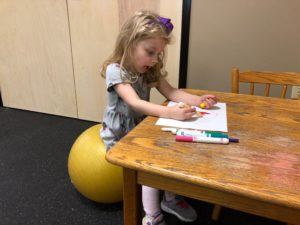
Visit www.abcpediatrictherapy.com for more!
Read More
In a world full of horses, don’t be afraid to be a unicorn
According to stopbullying.gov, around 49% of kids grade 4-12 admit to having experienced bullying at school at least once in the month preceding the survey.1 Bullying can happen to anyone, although youth with special needs are at increased risk for bullying.1 This could be because the child is perceived as different because s/he potentially cannot participate in the same physical activities as others, may have difficulty with self-regulation, may find it hard to communicate, and/or may present with behavior that makes him/her stand out from typically developing peers.
Recognizing the signs and taking action:
- Only 20-30% of kids report bullying to an adult1
- Bullying isn’t always physical. The most common types of bullying are verbal and social1
- Lack of peer support can lead to increased instances of bullying- ask your child about his/her friends, who s/he interacted with that day at school, and encourage friendships outside of the classroom1
- “If you see something, say something”: Encourage your kids to stand up for others. Studies show that “when bystanders intervene, bullying stops within 10 seconds 57% of the time”1
- Educate the teacher and classroom on your child’s disability. Have the child explain as much as s/he can and allow kids the opportunity to ask questions with you present
- Some children may not recognize that they are being bullied. Encourage open communication with your little one by asking questions about his/her day. You could start with, “Tell me about lunch today? Who did you sit with?”, or “What is it like to ride the school bus?”2
- Point out the positive things about your child regularly and help him/her to self-identify the good: you could ask questions like, “What do you like most about yourself?” or “Tell me 2 things you think you are really good at”. Remind your kids that it’s okay to be different!2
- Have tough conversations with your kids before they become tough situations. Discuss the difference between good friends and bad friends. Have your child help you make a list of positive and negative qualities in a friend so s/he can make good choices in peer relationships
- Encourage your kiddo to participate in special activities or have hobbies outside of school. This can help boost the child’s confidence and lead to friendships2
- Be a good role model: treat others with kindness and respect. Your kids learn from how they see you interact with others2
- Encourage your kids to talk to you about their interactions with their peers. If a child is being verbally bullied, recognize that they may be embarrassed to tell you exactly what was said3
- Be consistent with attending therapy appointments and following through with homework. We are here to help your kids succeed! We recognize the little things that may make their day tough, and we strive to provide them with techniques to help them achieve their goals and promote positive peer interactions
For more information on bullying, prevention, and additional resources, please visit: https://www.stopbullying.gov/

Information retrieved from:
- Facts About Bullying. (n.d.). Retrieved October 21, 2019, from https://www.stopbullying.gov/media/facts/index.html.
- How To Prevent Bullying (n.d.). Retrieved October 21, 2019, from https://www.stopbullying.gov/prevention/index.html
- Warning Signs For Bullying (n.d.). Retrieved October 21, 2019, from https://www.stopbullying.gov/at-risk/warning-signs/index.html
- Images retrieved from Bing Images
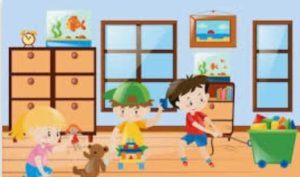
With the cold weather setting in, all us parents are ramping up for the increased energy of our children that can no longer go outside for very long! We all know that kids, and even adults, are not made to sit still indoors all day no matter how hard it is to keep them entertained. Here are a few ideas that can help to keep your kiddos regulated and happy along with you!
- Have a Dance party! Turn up the music, push back the coffee table and turn on that old dance light you have tucked away in your holiday gear. Visual (lights), auditory (sound) and proprioceptive (pressure) needs can all be met in this task!
- It might be cold outside but it can be a summer sensory bin indoors! Bring that water table indoors and fill it up with water beads or colored rice and have an out of season underwater play session!
- The traditional Fort building for bored children can provide a calming quiet area that children can read books or even take a nap, if we’re lucky! The actual task of building a fort can provide opportunities for heavy work such as carrying the blankets (calming proprioceptive input) and the cognitive problem-solving task of where to hang and put the blankets to construct it has wonderful benefits as well!
- Don’t be too quick to count out all the outdoor tasks. Sledding is a great vestibular task that can meet the needs of a child that may like to swing outdoors on sunnier days. It can also provide calming heavy (proprioceptive) input as they walk back up the hill whether they are pulling the sled back or not.
- Get your indoor adventure time on with an Animal Rescue!! Hide stuffed animals, weighted beanie babies are perfect, and have your child go find and rescue them! This can help to get them moving in a more motivated fashion while also applying their visual scanning skills and keep them busy for quite few minutes.
- Move that outdoor equipment indoors!! If you have a basement or area that can fit a small climbing structure, mini trampoline, slide or rollercoaster from outdoors in, hose it off now and keep the outdoor play going all winter!
- Make your own or just play with Playdough! This task can help to strengthen fine motor skill as you use approaching holiday cookie cutters for them to make their own “cookies” to design.
- Have a guess the animal Zoo-fari!! Have your child walk like various animals, kangaroo, frog, monkey, elephant etc, and guess what animal they are! This can provide calming pressure as well!
- Messy play sensory bins such as “oobleck” which is made out of corn starch and water, can be used for enticing their attention for a long time and providing such a different sensory experience that they couldn’t possibly be bored! Feel free to throw in safe plastic toys for a fun search as well!
- Channel your inner Frozen and freeze toys inside a container or ice tray. Fill up old ketchup or mustard containers and fill with warm water to squeeze and melt the toys out
Celeste Roberts, MS OTR/L

As parents we are conscious of our child’s sensory system likes and dislikes and often cater to them without even realizing. We rock them as a baby which is meeting their “vestibular need” or hug them when they are tired which provides input to their “proprioceptive” system that helps them to calm. What we are not often as aware of is that these sensory system needs are part of their “daily sensory diets”. Being a parent requires you to read their needs and adjust accordingly before they even have the words to tell us what they want or need. As they fidget and become fussy a quick 10 minutes of outside heavy work and some fresh air with built in deep breathing seem to work magic on their moods and ability to cope with life and the struggles it hands us all. It is actually not magic, but the magic of sensory regulation strategies.
Sensory Break examples:
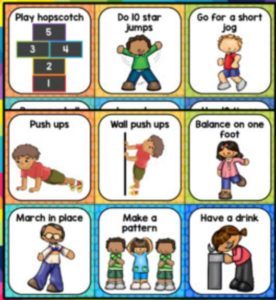
Every child, and every adult, has sensory needs throughout every day of their life and these needs fluctuate and change over time. This is a skilled intervention that occupational therapy can provide and help to find the just right challenge and just right sensory diet in order to increase positive mood, task focus, and independence for your children. On days that your child seems to be jumping around on the furniture more, running and “crashing” into the couch or bed they are most in need of proprioceptive input. On days that your child is having a harder time coping with even the littlest inconveniences or changes in schedule these proprioceptive tasks can also be helpful in calming our bodies such as hugs, jumping jacks, or jumping on a trampoline. If your child seems fearful of height, such as climbing to the top of an outdoor play structure, or is unwilling to swing or use a trampoline they are likely in need of skilled intervention in order to address this vestibular tolerance deficit. As parents we adjust to what our children need, though when realizing there are needs that are becoming harder to fulfil or is impacting your child’s ability to play with other peers, skilled occupational therapy may be the next step in the best thing you can do to help your child succeed!
Celeste Roberts, MS OTR/L

Read More
There are many different tapping methods available in the clinic and many reasons why we would try taping. See below for specific ways tape can be helpful and when we would not use tape. For children, tapping is most helpful with improving function and promoting postural control to help facilitate gross motor, fine motor, or oral motor skills.
Kinesiotaping can help with:
– Improve muscle function
– Improve sensory awareness
– Support ligaments and tendons
– Improve lymph/blood circulation
– increase range of motion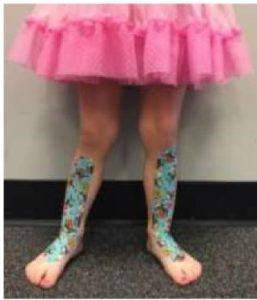
– Decrease edema/swelling
– minimize pain
– limit muscle fatigue
– delay onset of muscle soreness
– decrease scars/adhesions
– assist with organ dysfunction
– prevent injuries
– reposition joints
– improve postural alignment
– improve gross/fine/oral motor skills
– improve balance
– improve walking patterns
– facilitate breathing
It would not be appropriate to use Kinesiology taping with children that have the following:
– open wounds/cuts/scrapes/rashes on the areas that tape would be applied
– non-healed scars
– thin/fragile skin
– infected area
– kidney Problems
– a known allergy to adhesives/acrylic/silicone
– Congestive heart failure
– Deep Vein Thrombosis (DVT) or blood clot
Precautions would need to be taken with the following:
– Previous reactions to tape/adhesive
– Decreased sensation
– GI issues such as severe reflux
– Infant in NICU
– Rash/eczema
– Pica disorder
– Suspected DVT
– Taking anti – coagulant
– Diabetes, venous insufficiency peripheral neuropathy
As a pediatric physical therapist, I like to use taping to facilitate function. For example, I use tape to assist with heel strike with my kids that like to walk on their toes. This has been very successful with my sensory seeking toe walkers, especially because not only does it assist with muscle activation in the front of the foot it also provides sensory feedback to the brain. I also use it to assist with babies that have torticollis to assist with symmetrical posture and strengthening the weak side. It is very common for a baby with torticollis to favor a side throughout development due to one side of the body being weaker than the other. Tapping gives feedback to the baby to use their weaker side more appropriately. Taping can also be very helpful to prevent knee hyperextension with children that are hypermobile and like to lock their joints out. When children lock their joints out, they are not activating their muscles surrounding that joint appropriately and therefore not gaining strength. Taping can assist with placing the body in a more functional position so the child gains strength appropriately.
If you feel taping could help your child please feel free to speak to a physical therapist by contacting us at (513)-755-6600 or by https://www.abcpediatrictherapy.com/contact-us/
Read More Skip to content
Skip to content
